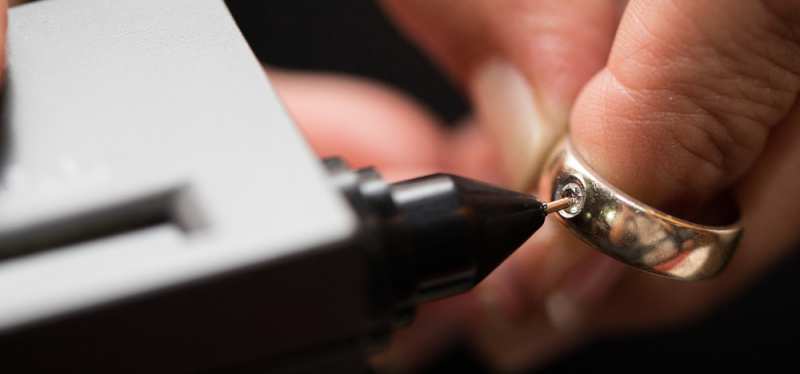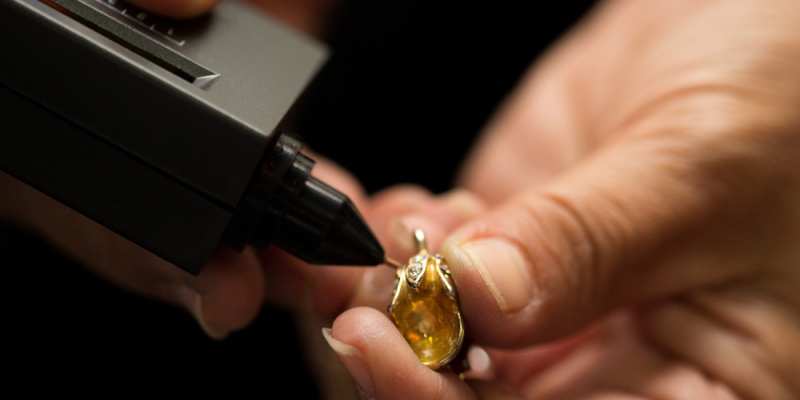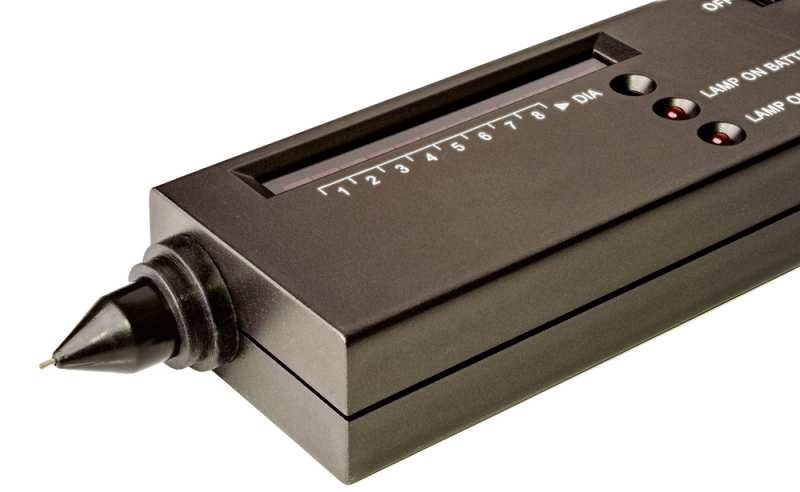We have all witnessed, at least in movies, the appearance and usage of a diamond tester. However, do we truly understand how this device works?
Given the frequency of this question, it cannot be overlooked. Therefore, we have taken the initiative to provide a comprehensive explanation of how this compact handheld machine functions and why it holds significant importance.
In a world where counterfeit diamonds are prevalent, this device proves invaluable to anyone involved in the diamond industry, whether as a seller or a buyer. It is in everyone’s best interest to authenticate the diamonds in question.
Our approach to explaining the workings of a diamond tester aims to provide a clear understanding without delving too deep into technical and mechanical complexities. We believe that many existing explanations are often difficult to grasp, as they are presented from a purely technical standpoint.
Now, without further ado, let us delve into the intriguing workings of this device and explore how it operates.
DESIGN YOUR OWN ENGAGEMENT RING: START WITH A SETTING OR START WITH A DIAMOND. IT’S REALLY UP TO YOU!

What Is A Diamond Tester?
Before diving into a detailed explanation, let’s first understand what a diamond tester is, how it is used, and its purpose.
The name itself gives a clue about its purpose, but let’s explore it further. A diamond tester is a portable device designed to determine the authenticity of diamonds and test materials for their thermal and electrical conductivity. Its compact nature and ease of use make it highly convenient and widely utilized.
These testers are commonly employed in jewelry stores, diamond dealerships, and specialized establishments involved in buying or selling diamonds. When it comes to the buying and selling process, the use of a diamond tester becomes particularly significant.
Jewelry stores typically procure diamonds directly from jewelry manufacturers or diamond dealers, accompanied by a certificate of authenticity. However, the scenario changes when individuals attempt to sell their diamonds. In such cases, there is often no certificate of authenticity, or even if one exists, it may not pertain to the specific diamond being presented.
This is where diamond testers come into play. They are employed to verify the authenticity of the diamonds and determine if the stones in question are genuine diamonds. It is astonishing (or rather disheartening) to discover the number of individuals who attempt to pass off glass, synthetic replicas, or similar materials as diamonds to gain financial advantage.
The precise method of using a diamond tester will be discussed later, but it is important to note that these testers are particularly useful when individuals are selling their diamonds or jewelry containing diamonds.
Even in situations where individuals sell diamonds to other individuals, having a diamond tester on hand is advisable. It ensures that both parties can witness the validation process and have confidence in the authenticity of the diamonds being exchanged.
This aspect is crucial because, unfortunately, diamond switching is a reality that exists.

How Do Diamonds Testers Actually Work?
Now, let’s delve into the technical and practical aspects of how diamond testers work.
First and foremost, it’s important to note that diamond testers operate using two primary methods: heat conductivity and electric conductivity. While both methods yield similar results, they have slight differences in their functioning.
Let’s explore each method individually to gain a better understanding. However, before we proceed, it’s crucial to remember that diamond testers work based on either heat or electric conductivity.
Method #1: Heat
Diamond testers that rely on heat conductivity are more commonly used and generally considered more reliable and faster in delivering results compared to their electric-based counterparts. Although both methods provide results within a few seconds, there is a slight difference in speed, which may not seem significant but holds importance.
Heat-based diamond testers function by testing the heat conductivity of the stone. Different gemstones exhibit varying levels of heat conductivity, and diamond testers are specifically designed to detect the characteristic heat conductivity level of diamonds.
These testers typically feature a small needle-like rod at the end, which is gently pressed against any part of the diamond. The needle is held in place for a few seconds, and the results are observed.
Now, let’s touch on the physics aspect related to heat conductivity. The heat conductivity of a diamond exceeds 2,000 Watts per meter per Kelvin. While the numerical value may not hold much meaning for the majority, it’s important to acknowledge this fact.
Additionally, it’s worth noting that diamonds, along with graphite and graphene, are the best thermal conductors at room temperature. All three materials are composed of carbon.
In practice, when the needle of a diamond tester is pressed against a diamond, two possible outcomes may occur, depending on the model of the tester. Firstly, the built-in display may show the heat conductivity level of the stone. Alternatively, a long and steady beeping sound may indicate that the heat conductivity levels suggest the presence of a diamond.
Regardless of the specific indication method employed by the diamond tester, the outcome remains the same. Therefore, there is no need to worry about different types of testers yielding different results. Both methods yield the same outcome, albeit through different means. You can use both types of testers, but the likelihood of obtaining consistent results is around 99.9%.
Method #2: Electricity
Electricity-conducting diamond testers are popular and widely utilized, particularly in jewelry stores and diamond dealerships. Heat-based testers are commonly owned by individuals for personal use, while professionals often prefer electricity-conducting diamond testers.
However, it is important to note that the preference for electric-based testers does not necessarily indicate greater reliability or accuracy. It simply reflects the prevalent choice within the diamond industry.
The primary distinction between heat and electricity tests lies in the electrical properties of diamonds. Unlike their heat conductivity, diamonds exhibit the opposite behavior when it comes to electricity.
This stark difference is the most significant factor between the two testing methods used to authenticate diamonds. Diamonds are electrical insulators, meaning they do not conduct electricity but instead insulate it.
When a stone is tested using electricity-conducting diamond testers, the device searches for the absence of electric currents, indicating the presence of genuine diamonds. If an electric-based diamond tester detects any electricity in the diamond, it will yield negative results or simply fail to show positive results. Conversely, the absence of electricity signifies that the tester is in contact with a genuine diamond.
These tests may appear more straightforward since the presence or absence of electricity determines the authenticity of a diamond. While this is generally true, it is worth noting that diamond dealers and jewelry stores predominantly utilize this method. Although our assumption is not supported by official information, it is likely due to the simplicity of the test.
In terms of accuracy, electric-based diamond testers are just as reliable, if not more so, than their heat-conducting counterparts. The testing process for these models is similar to that of heat testers. A needle at the end of the tester is gently pressed against the diamond, and the results are observed.
Electricity-conducting diamond testers often feature a built-in display that indicates the levels of electrical conductivity. The display typically lights up a green field if no conductivity is detected, while an orange or red field indicates the presence of some electrical conductivity. Furthermore, these testers often include a wheel at the top, which amplifies the electric energy being searched for during the test. This feature enables the detection of even minimal levels of electrical conductivity.
However, it’s important to note that electric-based diamond testers are generally considered more delicate than their heat-based counterparts. This is because some diamonds may have very low levels of electrical conductivity, which does not make them any less genuine. For instance, blue diamonds can exhibit electrical conductivity.
Lastly, it’s worth mentioning that electric-based diamond testers may have a higher price tag compared to heat-based testers. However, this does not necessarily indicate greater trustworthiness or reliability compared to their heat-conducting counterparts.

Our Final Thoughts
Now, let’s summarize the key points discussed in this article regarding diamond testers:
- Two main types of diamond testers are commonly used: heat-conducting and electricity-conducting testers.
- Both types are accurate and widely utilized for checking diamonds’ authenticity during sales or for validation purposes.
- It is recommended to test diamonds with both types of testers if available, as comparing the results provides the most accurate assessment.
- However, if you only have access to one type of tester, it is still reliable to trust its results.
- Models based on checking the electrical conductivity of diamonds are more frequently used by jewelry stores and diamond dealers.
- By understanding the functioning of diamond testers, you should now have a good grasp of this topic.
- Best of luck with your future diamond testing endeavors!


